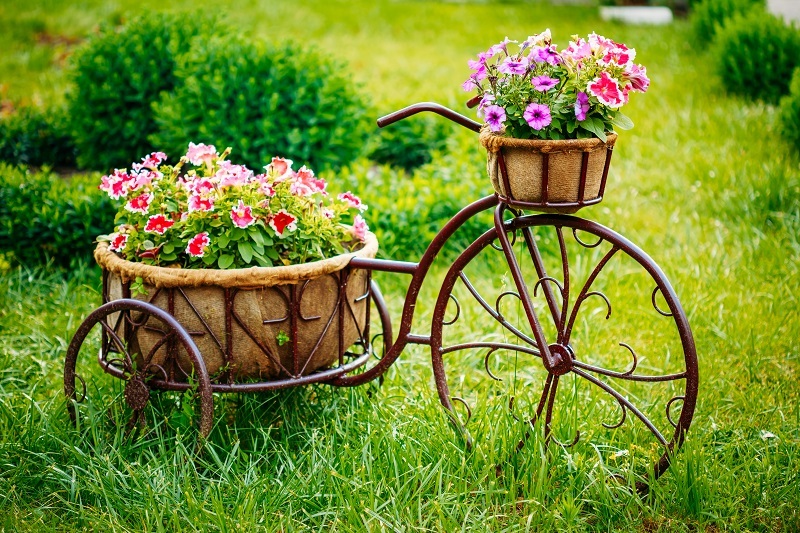Unlock the Secrets of Orchid Care
Posted on 13/08/2025
Unlock the Secrets of Orchid Care: Master the Art of Growing Orchids
Orchids are the jewels of the plant world, renowned for their exotic beauty, long-lasting blooms, and captivating diversity. However, these enchanting plants often intimidate both new and experienced gardeners alike. In this comprehensive guide, we'll help you unlock the secrets of orchid care, revealing tips and expert advice to keep your orchids thriving year-round.

Understanding the Basics: What Makes Orchids Unique?
If you want to master orchid care, it's important to understand what makes these plants so special. Orchids belong to the Orchidaceae family, a diverse group with over 25,000 species and more than 100,000 hybrids found all across the globe. Orchids possess remarkable adaptability, growing in rainforests, deserts, and even mountains. However, their unique growth habits and requirements set them apart from typical houseplants.
- Epiphytic orchids grow on trees, drawing moisture and nutrients from the air and surrounding debris rather than soil.
- Terrestrial orchids root directly in the ground, often needing loose, well-draining substrate.
- Sympodial and monopodial growth: Orchids grow either horizontally (sympodial) or vertically (monopodial), influencing their care and repotting techniques.
Popular Orchid Varieties for Indoor Growing
- Phalaenopsis (Moth Orchid): The most accessible and beginner-friendly, known for its long-lasting blooms.
- Cattleya: Celebrated for their large, fragrant, and vibrant flowers.
- Dendrobium: Boasting a stunning array of colors and shapes, tolerates a wider range of conditions.
- Oncidium (Dancing Lady): Features intricate blooms and grows well in bright light.
Creating the Ideal Orchid Environment
Unlocking the secrets of orchid care starts with recreating their native habitat. Follow these guidelines to ensure your orchids flourish indoors:
Light: The Lifeblood of Orchid Growth
- Indirect, filtered light is crucial for most orchids. Place them near east or west-facing windows or use sheer curtains to diffuse light.
- Phalaenopsis orchids prefer moderate light, while Cattleyas and Oncidiums can tolerate higher light levels.
- Leaf color can indicate light needs. Healthy leaves should be bright green; dark green signals too little light, while yellowish leaves may mean too much.
Temperature and Humidity: Mimicking Nature
- Most orchids thrive in daytime temperatures between 65?F-80?F (18?C-27?C) and night temperatures between 60?F-70?F (15?C-21?C).
- Provide a slight nighttime temperature drop to encourage blooming, especially for Phalaenopsis and Dendrobium orchids.
- Humidity should remain between 40-60%. Use a humidity tray, misting bottle, or room humidifier, especially during dry winters.
Air Circulation: Freshness for Vibrant Orchids
- Moderate air movement prevents diseases and helps orchids breathe.
- Use a gentle fan in the room (but avoid direct drafts), or open a window periodically for natural airflow.
Orchid Watering Secrets: Avoiding Common Pitfalls
The number one mistake in orchid care is overwatering. Orchids are not typical houseplants; their roots need both moisture and air.
Master the Right Watering Techniques
- Check the orchid medium before watering--if it's still damp, wait a few more days.
- Typically, water once a week in most climates, but adjust based on temperature, humidity, and orchid type.
- Water thoroughly, allowing water to drain out of the pot's bottom to prevent stagnant water and root rot.
- Never let roots sit in standing water. If your orchid pot doesn't have drainage, repot immediately!
- Use room-temperature distilled or filtered water for best results; tap water with high mineral content can harm delicate roots.
Humidity Tricks for Vibrant Orchids
- Cluster your orchids together to raise local humidity.
- Set pots on a tray of pebbles with water filled below the pot's base (never let roots touch standing water).
- Mist leaves in the morning so they dry by night; avoid spraying directly on blooms to prevent spotting.
Feeding Orchids: Nutrition for Spectacular Blooms
Fertilizing is key to unlocking orchid bloom secrets! Unlike many houseplants, orchids are sensitive to over-fertilizing, so less is often more.
The Best Orchid Fertilizer Practices
- Use a balanced fertilizer (20-20-20 or orchid-specific blends) diluted to half or quarter the recommended strength.
- Feed "weakly, weekly"--apply diluted fertilizer every other week during the growing season (spring through early fall). Reduce or withhold feeding in winter.
- Flush the potting medium with plain water monthly to remove excess salts and fertilizer buildup.
- Once flower spikes emerge, switch to a "bloom booster" fertilizer high in phosphorus to encourage long-lasting blossoms.
Signs of Nutrient Deficiency or Excess
- Yellowing leaves or poor growth may mean your orchid needs more nutrients.
- Leaf tip burn or limp roots suggest over-fertilization--back off and flush the medium with water.
Orchid Potting and Repotting Insights
Unlike typical pot plants, orchids require special growing media and containers to keep their unique roots healthy and vibrant.
Selecting the Right Potting Mix
- Use specialized orchid bark, sphagnum moss, or coconut husk; these allow airflow and swift drainage around the roots.
- Avoid regular potting soil: It retains too much moisture, causing root rot.
- Repot orchids every 12-24 months or when the medium breaks down and loses its structure.
How to Repot Orchids
- Gently remove the orchid from its old pot and wash away all old medium.
- Trim dead or mushy roots with sterilized scissors, keeping only healthy white or green roots.
- Place the orchid in a clean pot with fresh medium, distributing roots evenly.
- Water lightly post-repotting, then return to your usual care routine.
Encouraging Orchid Blooms: The Final Flourish
Unlocking the most anticipated secret of orchid care--gorgeous, repeat blooms--relies on understanding the triggers that set flower production in motion:
Essential Blooming Tips
- Maintain the correct light levels—insufficient light is the most common reason orchids refuse to bloom.
- Provide a 10-15?F (5-8?C) nighttime temperature drop for a few weeks, simulating seasonal changes and jumpstarting flowering (especially for Phalaenopsis and Cattleya).
- Prune faded flower spikes only down to the next node (bump) for Phalaenopsis—this can trigger a new spike.
- Ensure your orchid is mature enough; juvenile plants may need a year or two before they bloom naturally.
Dealing With Problems: Orchid Pests and Diseases
Even with the best orchid care, issues may arise. Here's how to identify and address the most common orchid problems:
Common Orchid Pests
- Mealybugs and scale: Look for cottony or waxy spots on leaves and stems. Wipe away with isopropyl alcohol, repeat as necessary.
- Aphids and spider mites: Rinse leaves and boost humidity to deter these pests. In severe cases, use insecticidal soap or neem oil.
Disease Prevention and Restoration
- Root rot: Caused by overwatering or poor drainage. Repot and trim damaged roots; improve your watering technique.
- Leaf spotting/fungal infection: Remove affected leaves, increase air movement, and avoid overhead watering. Use fungicides only if needed.
Additional Secrets to Long-Term Orchid Health
- Rotate your orchid every week to ensure even light exposure and growth.
- Keep orchids away from fruit bowls; ripening fruit emits ethylene gas, which can cause blooms to drop prematurely.
- Label your orchids with their name, origin, and care needs to keep track of the different requirements for each type.
- Stay observant! Early detection of pests, diseases, or stress gives you a head start in keeping your orchid healthy.
Embrace the Joy of Orchid Growing
Unlocking the secrets of orchid care is both a science and an art. By understanding the unique needs of your orchid houseplants--from optimal light and humidity to precise watering and feeding--you'll be rewarded with breathtaking displays of color and beauty year-round. Rather than a challenge, think of orchid care as an exciting journey, where each new leaf or flower spike is a triumph of patience and skill.
Ready to begin or level up your orchid-growing adventure? Apply these orchid care tips with confidence, and soon you'll be enjoying the magic and splendor of healthy, thriving orchids in your own home.

Frequently Asked Questions About Orchid Care
How do I know when to water my orchid?
Check the potting medium; only water when it feels dry an inch below the surface. Most orchids prefer a thorough watering once a week.
Why won't my orchid bloom again?
Insufficient light is the most frequent reason. Make sure your orchid is mature, receives the correct temperature drop, and is not overfed or overwatered.
Do I need to mist my orchid every day?
Misting is optional, but can boost humidity, especially in dry climates. Misting in the morning only is best. Do not let water pool in the crown of monopodial orchids, as this can lead to rot.
Can I grow orchids outdoors?
Yes, in mild climates many orchids thrive outdoors shaded from harsh sun. Protect from strong winds, frost, and extreme heat.
Conclusion: Unlocking Orchid Success
With the right knowledge and attention to detail, caring for orchids becomes a rewarding and relaxing pursuit, gracing your home with spectacular color and fragrance. By following the secrets and best practices in this guide, you can confidently nurture healthy, thriving orchids for years to come. So, start unlocking the secrets of orchid care today--your spectacular blooms await!
Latest Posts
Brighten up their special day with these top birthday flowers
Unlock the Secrets of Orchid Care
Explore the Unique Insights of Your Birth Flower





